29 Lightest Fabrics For Clothing That Enhance Comfort and Style
Choosing the right fabric is important for making comfortable and stylish clothing. Lightweight fabrics offer breathability and ease, which are especially valuable for warm weather and activewear. Understanding these fabrics helps designers and consumers pick materials that fit their needs.
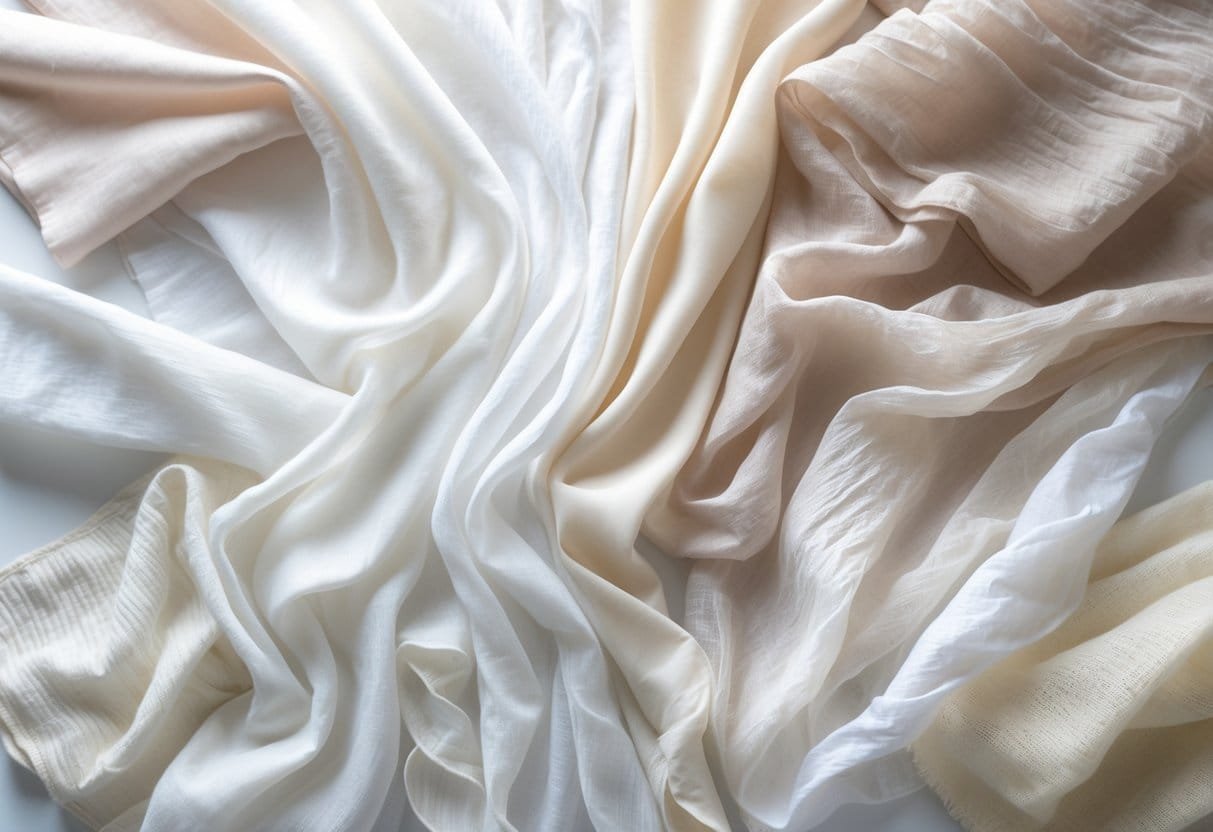
This article presents a collection of 29 of the lightest fabrics for clothing, highlighting their qualities and uses. It provides useful information for anyone interested in lightweight, breathable, and comfortable clothing options.
1) Cotton Voile

Cotton voile is a lightweight and breathable fabric. It is made from fine cotton threads woven tightly but with a slight sheerness. This makes it ideal for warm weather clothing.
The fabric feels soft and smooth to the touch. It drapes well, creating elegant folds and shapes in garments. Cotton voile is often used for summer dresses, blouses, scarves, and children’s wear.
Its semi-transparent quality allows air to flow easily, keeping the wearer cool. Cotton voile works well for both casual and more dressy items. It also shows good versatility for different styles.
Because it is made from cotton, cotton voile is comfortable and easy to care for. It is breathable, making it a good choice for active days in the heat.
Designers favor cotton voile because it combines lightness with durability. It can hold delicate shapes while remaining soft and flowy. This fabric is an essential option for lightweight clothing collections.
2) Chiffon
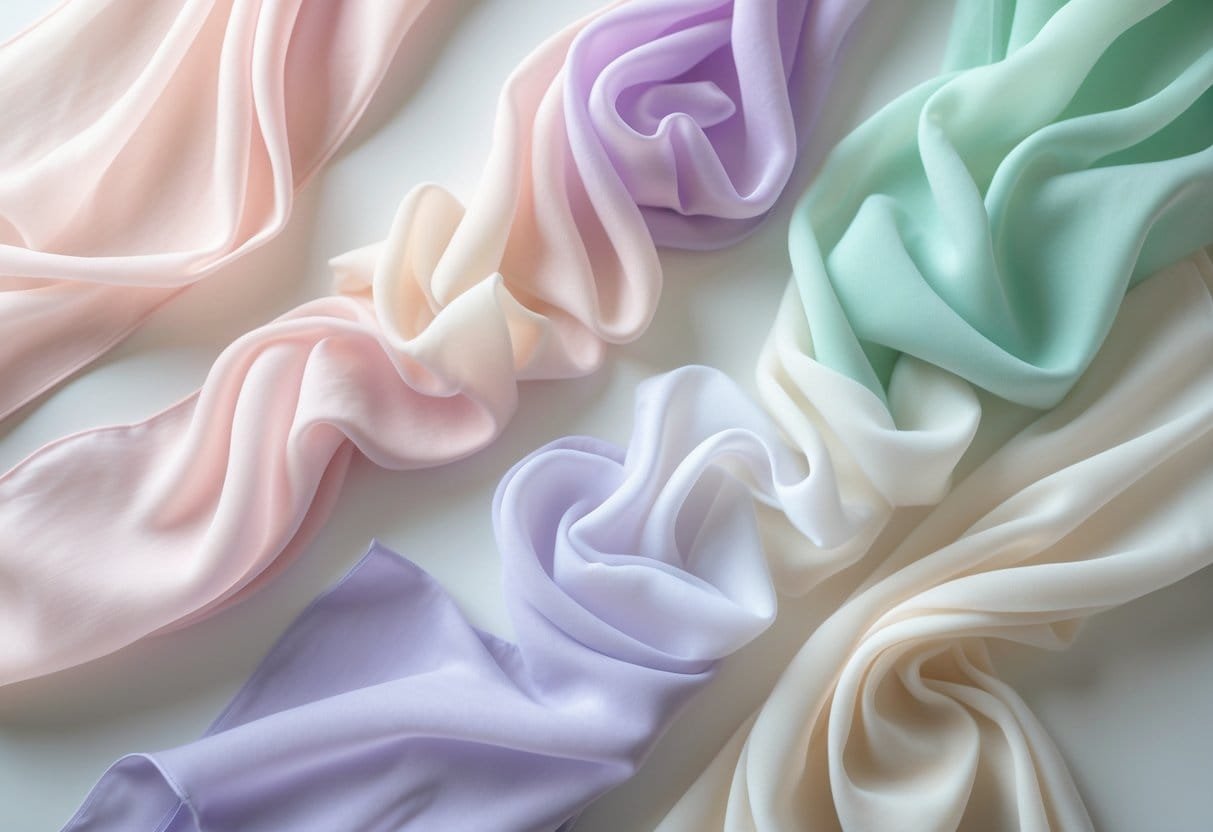
Chiffon is a lightweight fabric known for its sheer and airy quality. It has a mesh-like weave that gives it a slightly transparent look. This fabric often feels soft but has a slightly rough texture due to its tight yarn twist.
Originally made from silk, chiffon is now also made from polyester, nylon, cotton, or rayon. These materials make chiffon more affordable and widely available. It drapes well, making it popular for dresses, blouses, and scarves.
Because chiffon is thin and delicate, it can fray easily. It requires careful sewing techniques like French seams or bound edges to keep it from unraveling. This care makes it ideal for elegant clothing where a light and floaty effect is desired.
Chiffon stands out for combining elegance with breathability. It is common in evening wear and summer clothing. Its versatility suits both casual and formal designs, offering comfort without adding weight.
3) Tencel
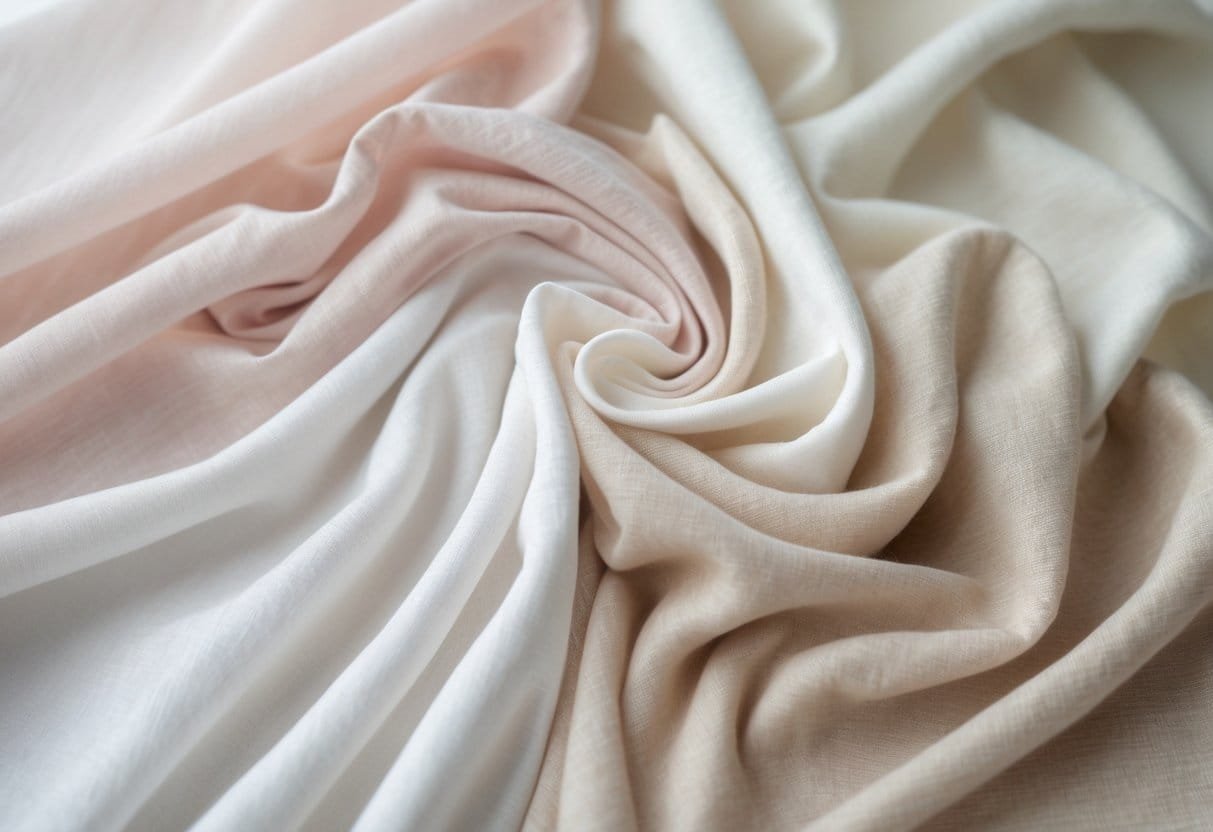
Tencel is a lightweight fabric made from wood pulp. It has a smooth and soft texture that feels comfortable on the skin.
This fabric is known for its breathability. It helps keep the wearer cool by managing moisture well. This makes it a good choice for warm weather and activewear.
Tencel also has the ability to regulate body temperature. It can keep people comfortable in both hot and cold conditions. This helps make clothing suitable for different seasons.
In addition, Tencel is considered eco-friendly. It is made through a sustainable process with less water and energy compared to other fabrics.
Because of its softness and durability, Tencel is used for many types of clothing. These include casual wear, activewear, and even more formal styles.
Overall, Tencel blends comfort, performance, and environmental care in one lightweight fabric option.
4) Linen
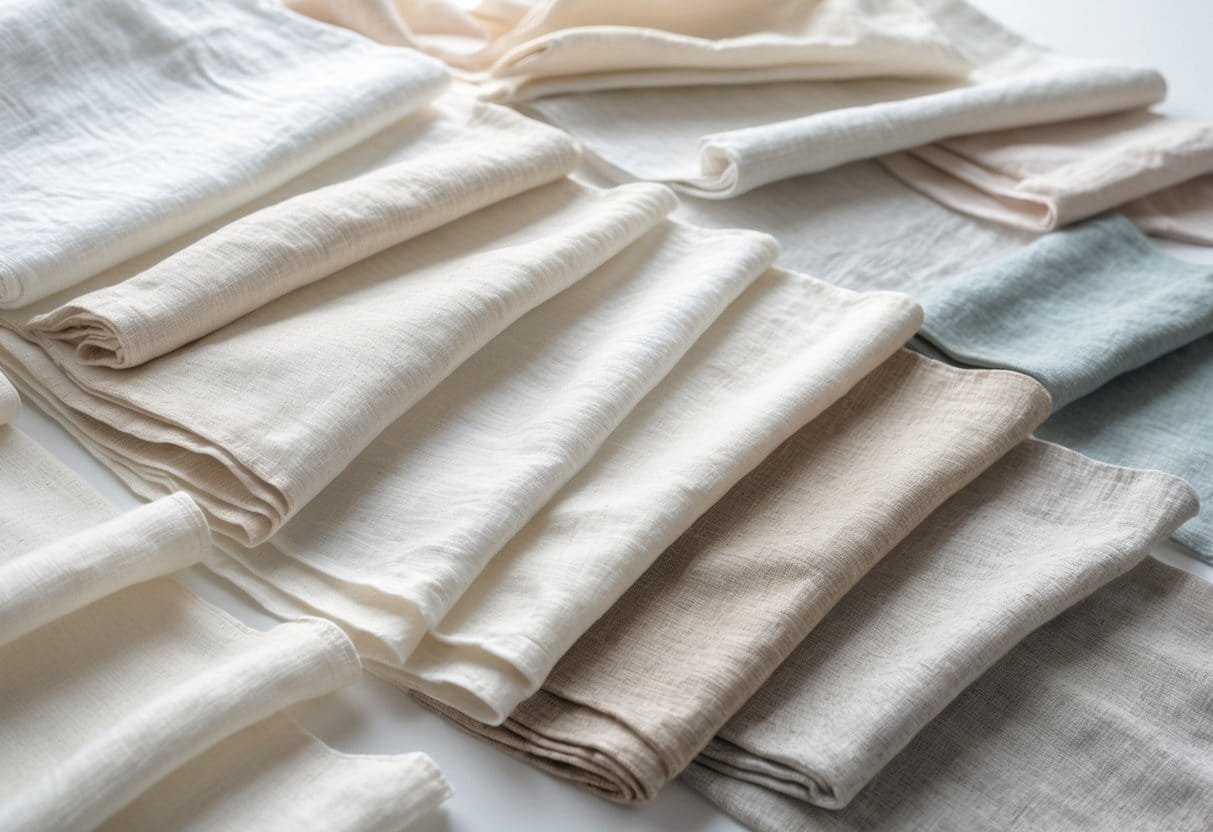
Linen is a classic lightweight fabric known for its breathability and strength. It is made from flax fibers, which give it a natural texture and durability. Linen is often chosen for summer clothing due to its ability to keep the wearer cool.
The fabric feels light and soft while remaining sturdy enough for regular use. Linen garments include dresses, shirts, and pants that offer comfort in warm weather. Its fibers allow air to pass through easily, making it suitable for hot climates.
Linen has a natural look and can wrinkle easily, which is part of its charm. It works well for both casual and formal wear. Lightweight linen can also be used in home textiles like sheer curtains and tablecloths.
Overall, linen balances comfort and durability. It stays breathable without sacrificing strength, which is why it remains popular in clothing. This fabric suits people who want a natural, cool, and reliable option.
5) Rayon

Rayon is a lightweight fabric made from natural cellulose fibers. It is soft to the touch and has a smooth feel, similar to silk. This makes it a popular choice for summer clothing.
The fabric drapes well, which means it falls gracefully on the body. Because of this, it works well for dresses, blouses, skirts, and scarves. It allows for good air circulation, helping keep the wearer cool in warm weather.
Rayon is also absorbent, making it comfortable to wear in hot and humid conditions. It is often chosen for its breathability and ease of movement. Designers like rayon for its versatility and stylish look.
Despite being lightweight, rayon can be durable if cared for properly. It is not as strong as some synthetic fabrics but offers a balance of comfort and style. Rayon blends can also enhance its performance and increase its uses.
6) Silk Georgette
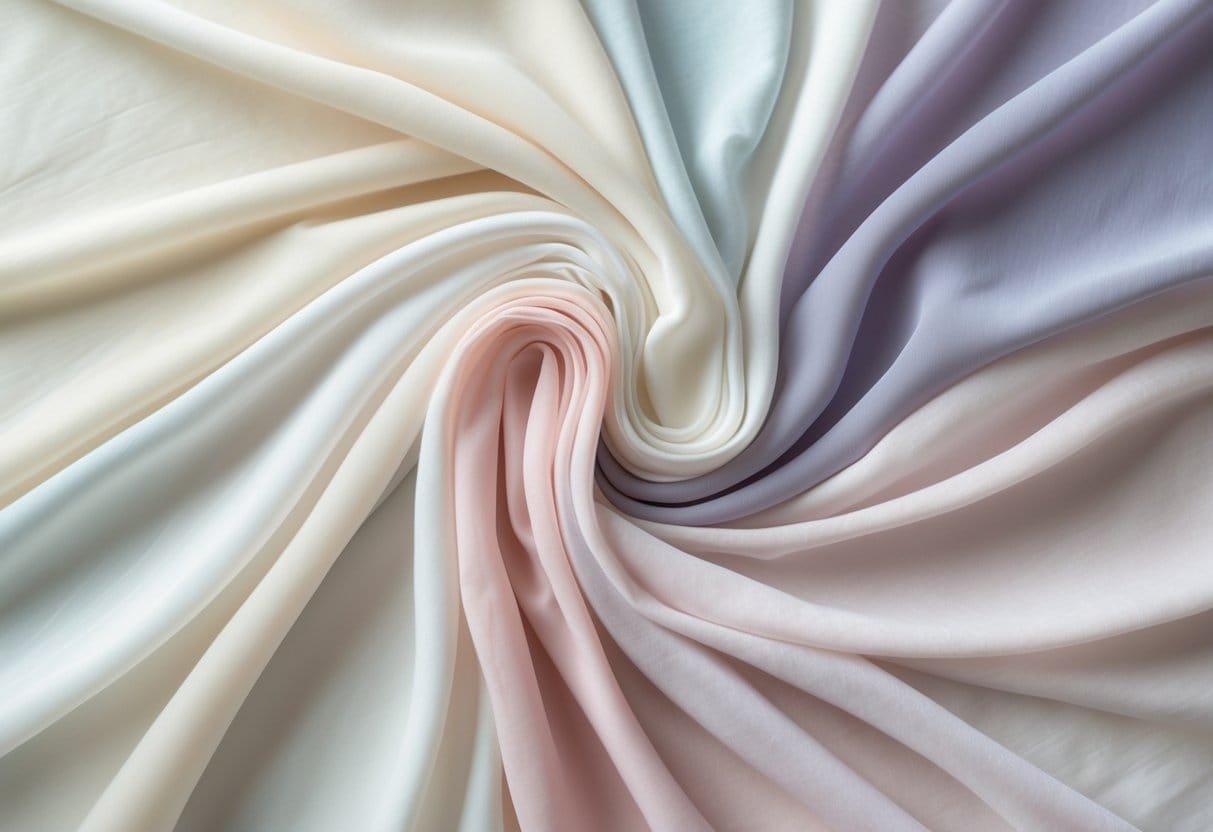
Silk georgette is a lightweight, sheer fabric known for its soft drape and slightly textured surface. It has a matte finish and a crinkled feel, which comes from twisted yarns used in its weaving. This texture makes it different from similar fabrics like chiffon.
The fabric works well for clothing that needs a delicate, flowing look. It is often used for dresses, blouses, scarves, and skirts. Its lightweight nature makes it breathable and comfortable to wear.
Silk georgette comes in many colors and prints. Designers appreciate its versatility because it can be used in both casual and formal clothing. It pairs well with other lightweight fabrics like crepe and crêpe de Chine.
Because it is sheer, silk georgette is often layered in garments to give it shape and modesty. It holds up well if handled gently, but it requires care during washing and storage to maintain its quality.
7) Chambray
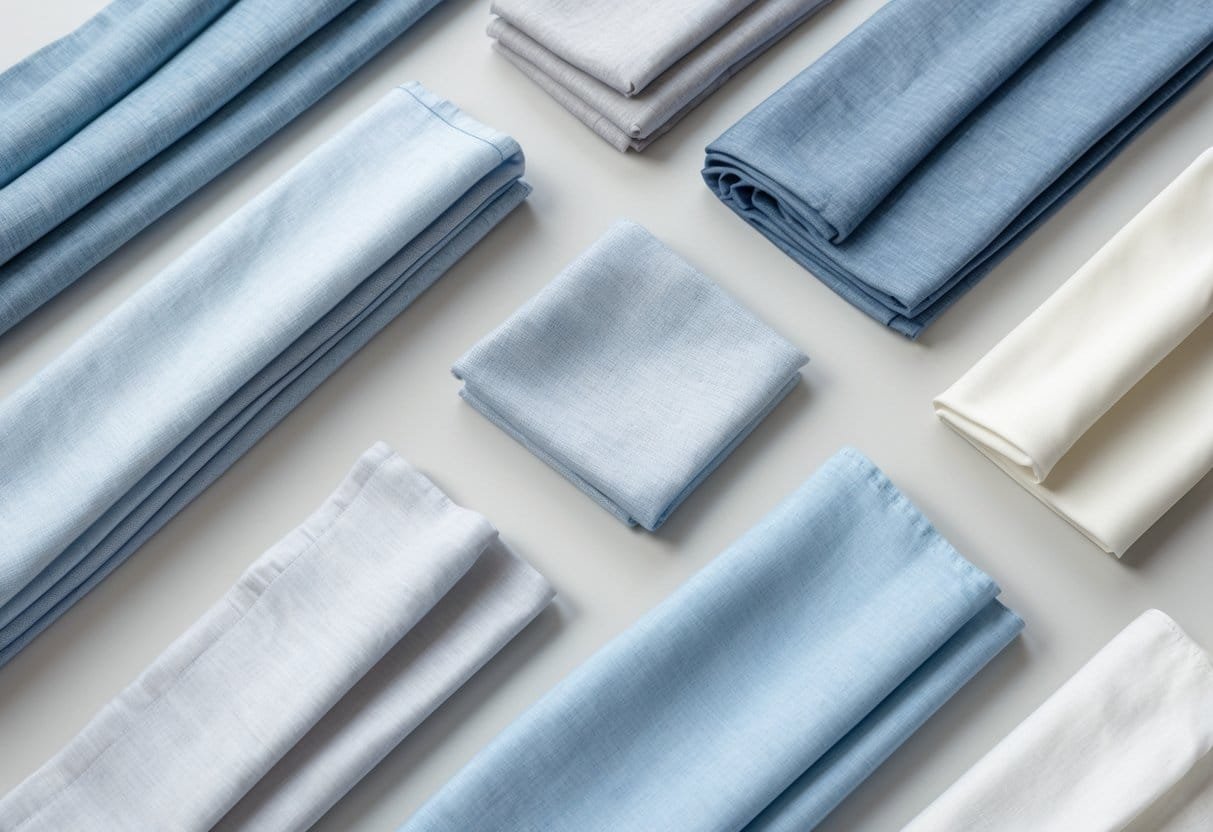
Chambray is a lightweight fabric often used as a breathable alternative to denim. It is made with colored warp threads and white weft threads, giving it a soft, two-tone look. This plain weave makes chambray lighter and more comfortable for warm weather.
The fabric is known for its versatility. It is common in casual clothing like shirts and dresses but can also work in semi-formal wear. Chambray offers the denim look without the heavy weight and stiffness.
Chambray is easy to care for with simple washing in cold water and air drying. Its breathability and softness make it popular for summer and transitional seasons. It has a long history, originating in France in the 16th century.
Overall, chambray balances style, comfort, and lightness. It suits those who want a fabric that works in many situations and feels cool to wear.
8) Batiste
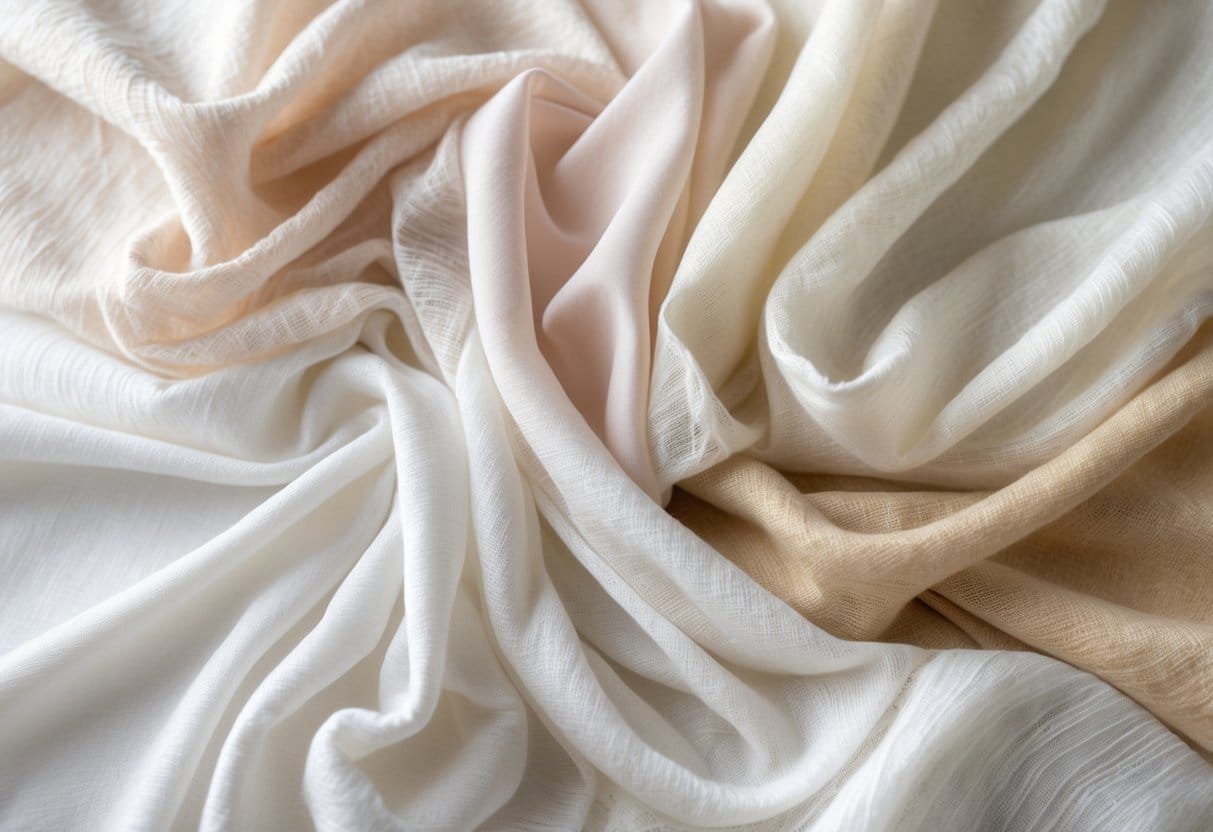
Batiste is a lightweight, plain weave fabric known for its soft and smooth texture. It is most often made from cotton, but can also include blends with polyester or rayon. Its fine yarns create a closely woven, semi-sheer material.
This fabric is breathable and comfortable, making it ideal for warm weather clothing. Designers frequently use batiste for dresses, blouses, and shirts that need to feel light and airy.
Batiste has a slightly crisp feel but remains soft against the skin. It is easy to sew and works well for layering or delicate garments.
Its natural breathability and lightness make batiste suitable for those who want clothing that stays cool without added bulk. It is also favored for its approachable care requirements and versatility in designs.
9) Modal

Modal is a lightweight fabric made from beech tree pulp. It is part of the rayon family but is known for being softer and more breathable than many other fabrics.
This fabric feels silky and smooth, making it comfortable to wear. It also absorbs moisture well, which helps keep the skin dry.
Modal is often blended with other fibers like cotton or polyester. These blends combine softness with added strength and durability.
Because modal is plant-based and made from natural materials, it is considered more eco-friendly than some synthetics. It also holds color well and resists shrinking after washing.
Its lightweight and breathable qualities make modal a popular choice for summer clothing. It works well in shirts, dresses, and underwear where comfort and airflow matter most.
10) Seersucker
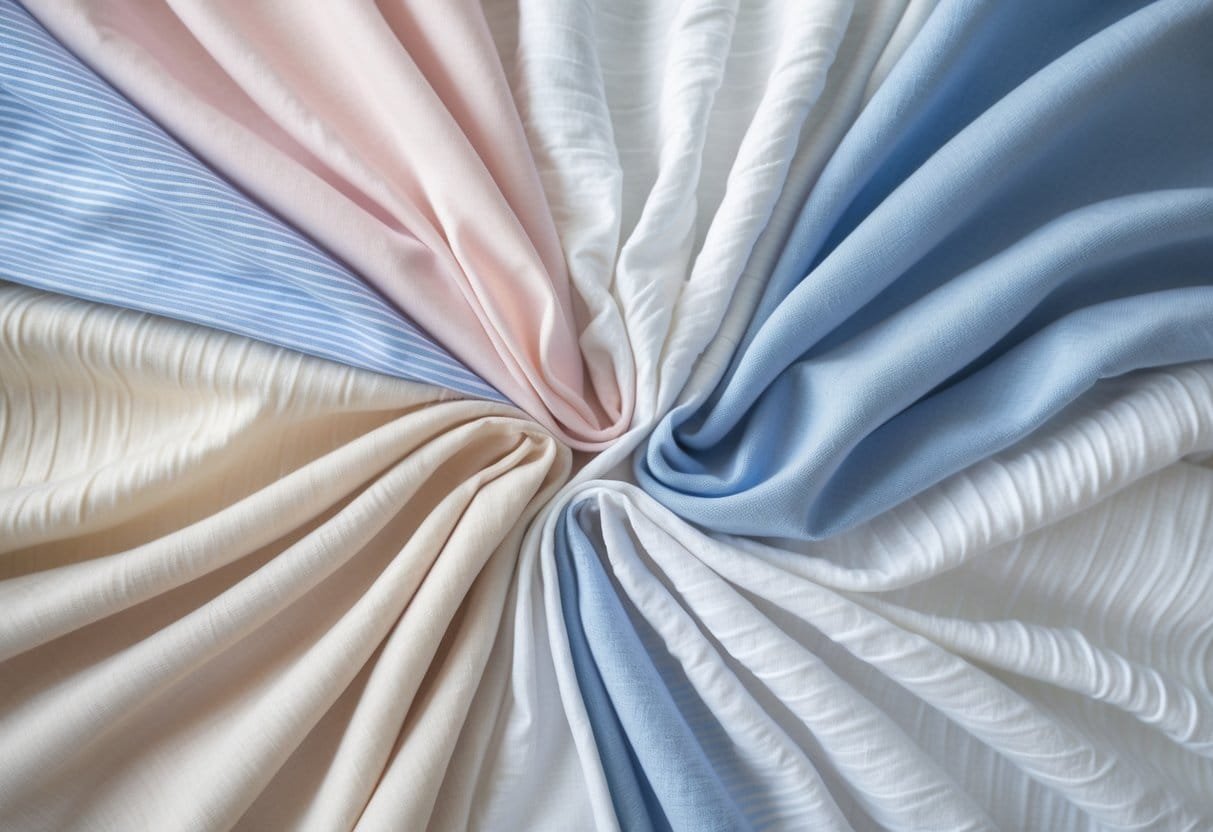
Seersucker is a lightweight cotton fabric known for its puckered, crinkled texture. This texture is created during weaving by varying thread tension. It gives the fabric a mix of smooth and raised stripes or checks.
The unique texture keeps the fabric slightly away from the skin. This allows air to flow freely, helping to keep the wearer cool in warm weather. Because of this, seersucker is popular for summer clothing.
It is often used in dresses, suits, and casual wear. Seersucker’s breathability and light weight make it comfortable to wear in hot climates.
The fabric has a low-maintenance quality. It naturally resists wrinkles, which reduces the need for ironing.
Seersucker has a long history and remains a classic fabric choice. Its combination of comfort, style, and practicality ensures it stays in fashion for warm-weather clothing.
11) Jersey Knit

Jersey knit is a lightweight fabric known for its softness and stretch. It is made using a knitting process that creates a smooth surface on one side and a textured surface on the other.
Originally made from wool, jersey knit now comes in cotton, silk, and synthetic fibers. This variety allows it to be used for many types of clothing, from t-shirts to dresses.
The fabric drapes well and offers good flexibility. Its stretch is usually stronger across the width than along the length, depending on the type.
Jersey knit is popular for casual wear and activewear. It adapts well to different seasons, with lighter weights suitable for summer and slightly heavier ones for cooler weather.
12) Hemp Fabric

Hemp fabric is known for being lightweight and breathable. It offers good comfort, making it a popular choice for summer clothing and casual wear.
This fabric is also strong and durable. It stands up well to everyday use, which makes it suitable for various types of garments, from shirts to workwear.
Hemp is a natural material that is eco-friendly. It grows quickly and requires less water than many other plants, which helps reduce environmental impact.
Hemp fabric blends well with other fibers like cotton or polyester. These blends can improve softness and flexibility while keeping the benefits of hemp’s breathability.
Overall, hemp fabric provides a balance of comfort, durability, and sustainability. It works well for people who want lightweight clothing that lasts and has an earth-friendly profile.
13) Muslin

Muslin is a lightweight cotton fabric known for its soft texture and plain weave. It allows air to flow easily, making it ideal for warm weather clothing. Its breathability helps keep the wearer cool and comfortable.
There are different types of muslin, including plain, gauze, bleached, and unbleached. Each type suits different needs, from summer dresses to baby clothing. This variety adds to muslin’s versatility for many clothing styles.
Muslin is also valued for being gentle on the skin, which is why it is often used in baby garments. Besides clothing, it is common in home textiles like curtains and tablecloths.
This fabric is easy to work with and widely used in fashion and crafting. Its lightweight nature makes it a popular choice for casual summer wear and layering pieces.
14) Organza
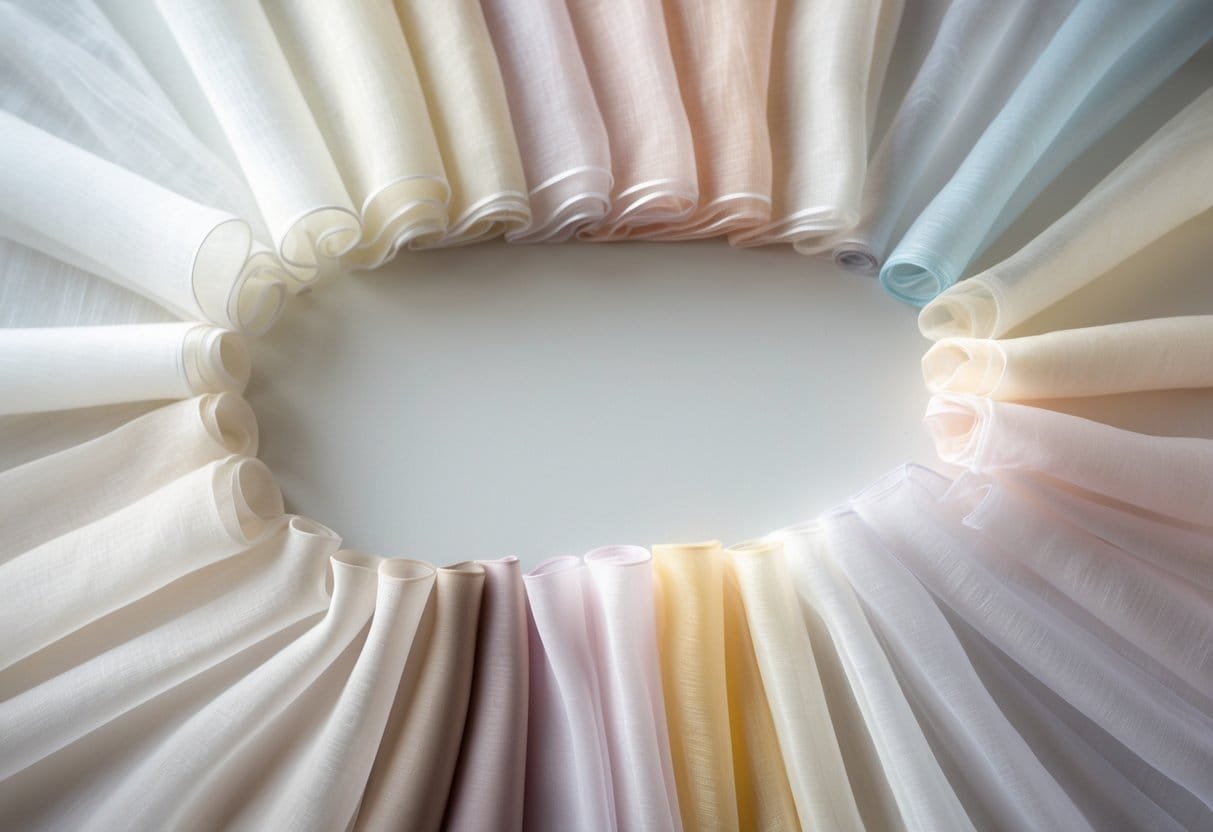
Organza is a lightweight, sheer fabric known for its crisp texture and slight shine. It is traditionally made from silk but can also be produced with synthetic fibers like polyester. This gives it a delicate yet structured feel.
The fabric is popular for creating elegant, voluminous clothing such as evening gowns and wedding dresses. Its stiffness allows garments to hold shapes, making it ideal for layered designs and overlays.
Organza is also used in decorative crafts and home accents because of its translucent look. Although light and thin, it has enough body to create soft silhouettes without feeling heavy.
It requires careful handling when sewing due to its fragile nature. Despite this, it remains a favorite for projects that need a combination of elegance and structure.
15) Poplin
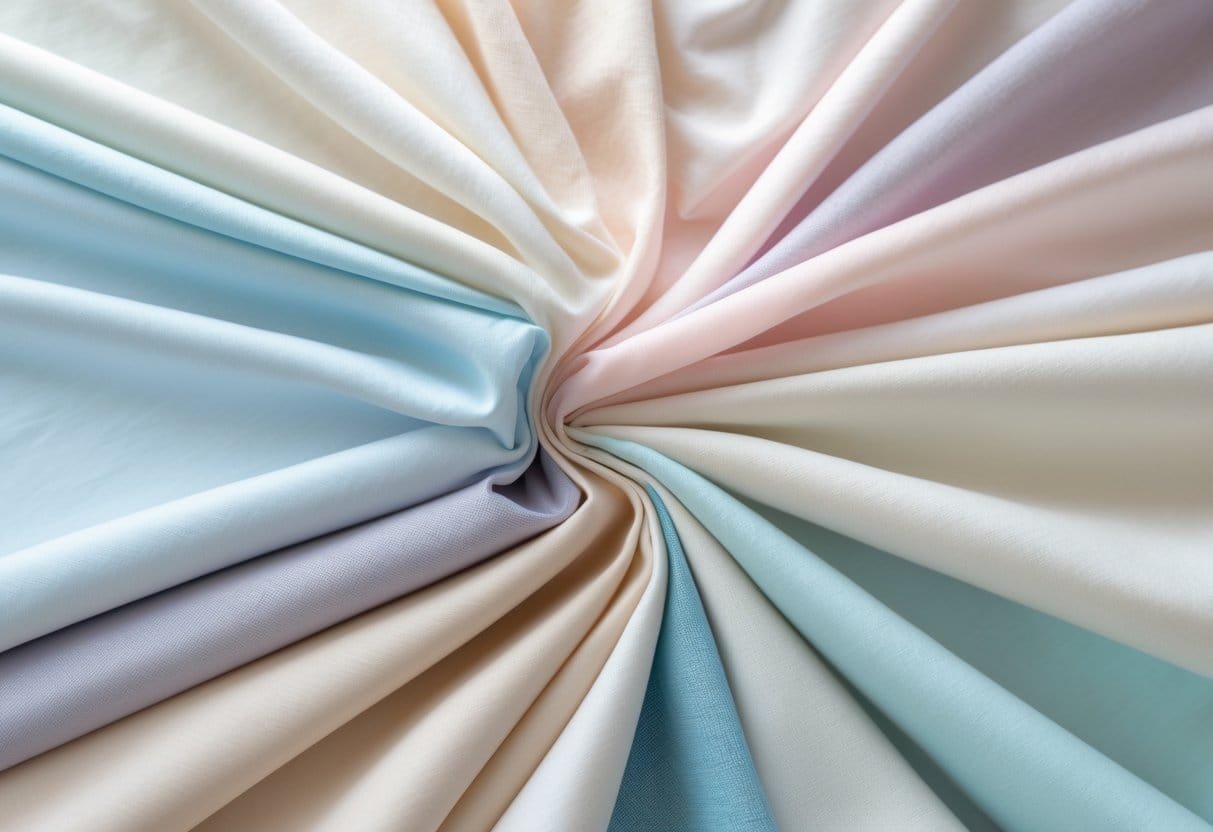
Poplin is a tightly woven fabric made mostly from cotton. It is lightweight, smooth, and has a crisp feel. These qualities make it a popular choice for clothing like shirts, dresses, and blouses.
It is breathable and comfortable, especially in warm weather. However, poplin can wrinkle easily and may be slightly see-through when used in lighter weights.
Poplin also comes in different weights. Light poplin is soft and airy, while heavier versions are stronger and more durable. This range makes poplin useful for both casual wear and more formal clothing.
Care for poplin usually involves washing in cold water and avoiding bleach. This helps keep the fabric’s texture and strength intact over time.
16) Voile

Voile is a lightweight, plain-woven fabric commonly made from cotton or a cotton blend. It has a higher thread count than many cotton fabrics, giving it a soft and smooth feel. This makes voile gentle and comfortable against the skin.
The fabric is semi-sheer, which allows air to pass through easily. This quality makes it very breathable and suitable for warm weather. Voile’s light texture helps keep clothing cool and airy.
Voile is often used for summer dresses, blouses, and lightweight curtains. It drapes nicely and comes in many colors and patterns, such as florals, stripes, and polka dots. Its versatility extends to casual and dressier styles.
Because it is delicate, voile needs gentle care, usually hand washing or using a mild cycle. It does not weigh down the wearer, making it a popular choice for breathable and soft clothing in hot climates.
17) Batiste Cotton
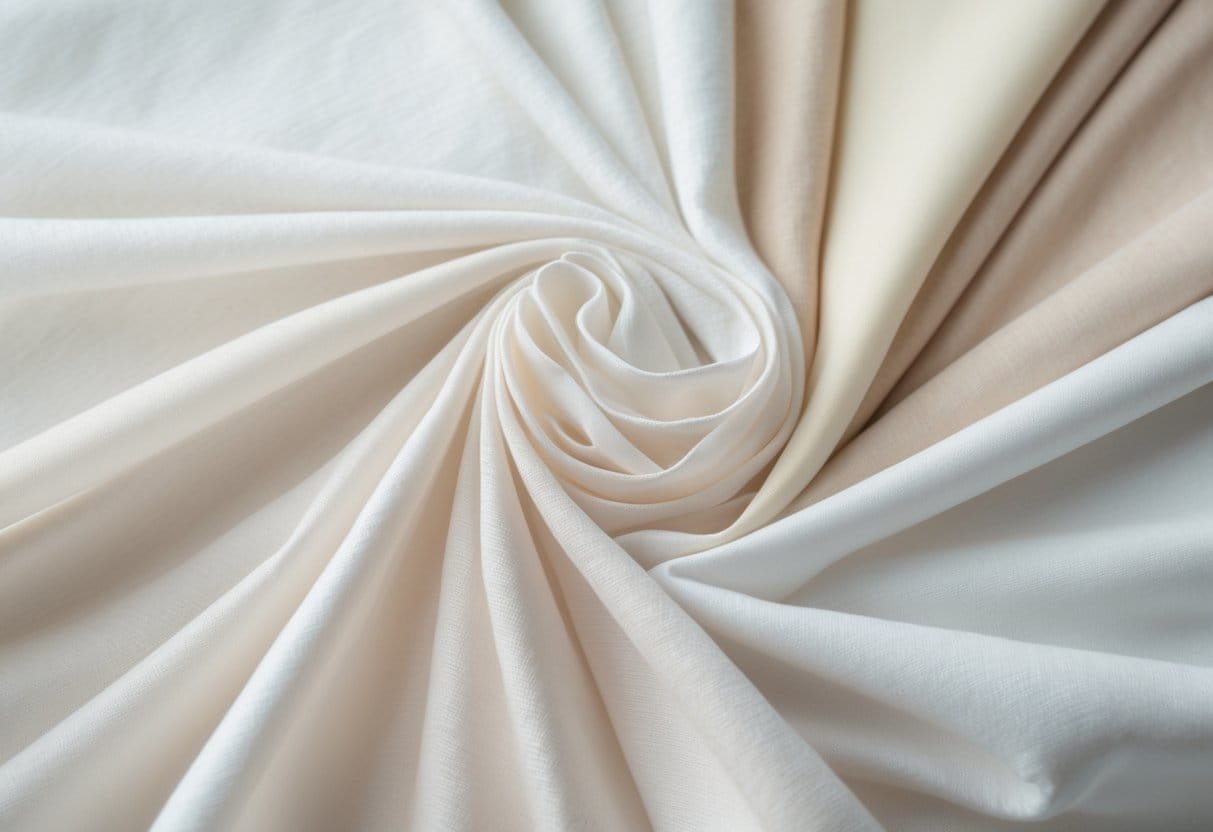
Batiste cotton is a lightweight, plain-weave fabric. It is mostly made from cotton fibers, but sometimes blends include rayon or polyester. This fabric is soft and has a slightly sheer look.
It is breathable and comfortable, making it a popular choice for summer clothing. Designers often use batiste cotton to make dresses, blouses, and shirts because it feels cool in warm weather.
Batiste cotton is also known for its delicate appearance while still being strong enough for everyday wear. It is often used as a lining fabric in high-quality garments because of its smooth texture.
The fabric usually comes in solid colors like white, but it is available in patterns and prints as well. It is sold by the yard at fabric stores for sewing and crafting projects.
Because of its lightweight and breathable nature, batiste cotton helps keep the wearer comfortable in hot and humid conditions. It combines elegance with practicality, making it suitable for various fashion needs.
18) Cupro

Cupro is a lightweight fabric made from cotton linter, which is a byproduct of cotton processing. It is a regenerated cellulose fiber, meaning it is created by recycling small cotton fibers that are usually thrown away. This makes cupro an eco-friendly option for clothing.
The fabric has a smooth, silky texture and a soft shine. It drapes well, giving clothes an elegant and flowy look. It is breathable and feels comfortable on the skin, making it suitable for warm weather.
Cupro is often called “vegan silk” because it looks and feels like silk but avoids animal use. Its production uses a closed-loop process that recycles chemicals to reduce environmental harm. Designers appreciate cupro for its sustainability and versatility in both casual and formal wear.
19) Polyester Microfiber

Polyester microfiber is made from very fine polyester threads. These threads are thinner than traditional polyester fibers, which makes the fabric lightweight.
The fabric is strong and durable despite its lightness. It is soft to the touch and feels smooth on the skin.
Polyester microfiber dries quickly and resists wrinkles, making it easy to care for. It is often used in clothing such as shirts, dresses, and activewear.
This fabric also allows for good breathability because of its thin threads. It can be worn comfortably in warm weather.
Polyester microfiber is popular because it combines the benefits of polyester with a lighter, softer feel. It offers durability and convenience without extra weight.
20) Nylon Mesh

Nylon mesh is a lightweight fabric known for its breathability and durability. It has a net-like structure that allows air to pass through easily, making it ideal for clothing that needs to stay cool.
This fabric is often used in sportswear and activewear. It helps keep the wearer comfortable by allowing moisture and heat to escape.
Nylon mesh is also popular for bags, backpacks, and pockets. Its strength supports everyday use while remaining light enough to avoid adding bulk.
The fabric is versatile and easy to work with for many sewing and crafting projects. It holds its shape well and dries quickly after washing.
Because of these qualities, nylon mesh is a practical choice for designs that need to balance function and comfort.
21) Tulle
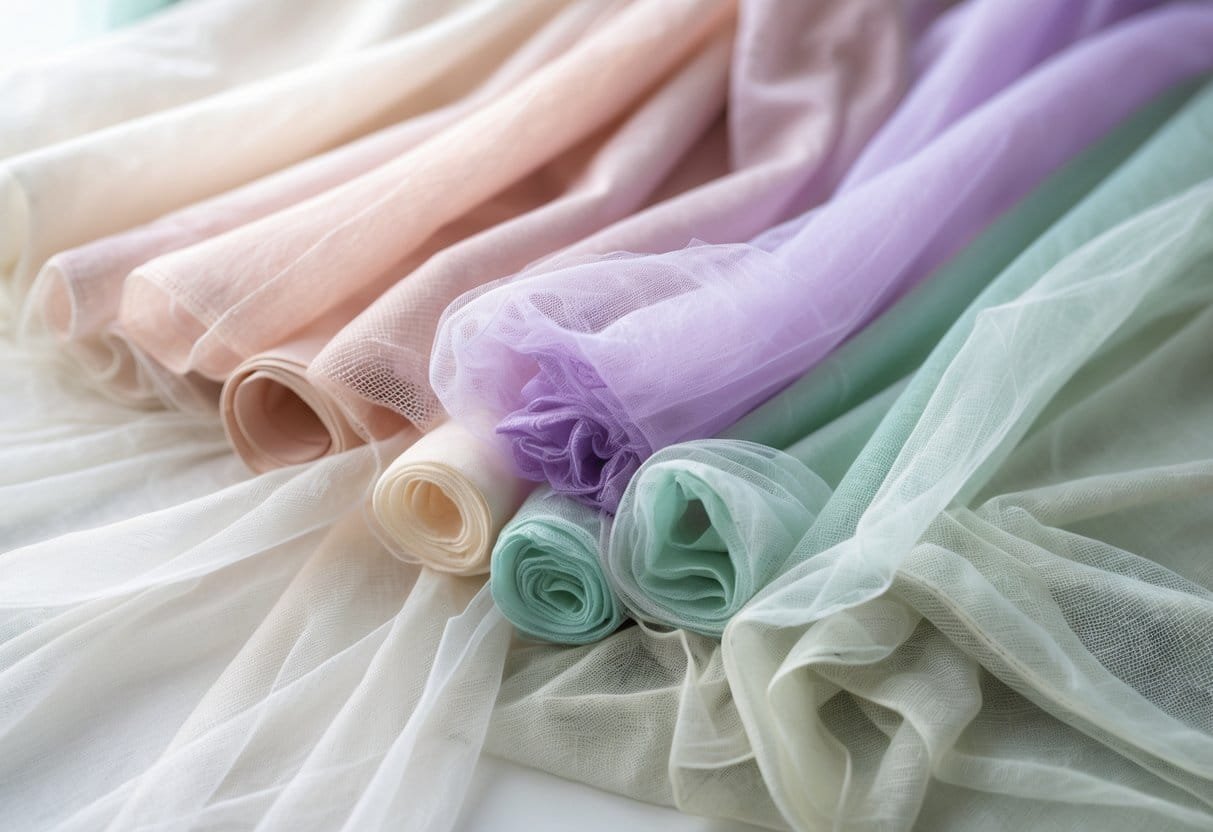
Tulle is a very lightweight fabric made from fine netting. It is usually made of polyester, nylon, or silk. The fabric has a stiff but delicate feel due to its hexagonal weave pattern.
Tulle is known for being sheer and breathable. Its lightweight nature makes it ideal for adding volume without weight. It is often used in bridal dresses, veils, ballet costumes, and other formal wear.
The fabric offers slight elasticity, which helps it hold shape while maintaining softness. Tulle can range from soft and flowy to stiff and structured, depending on the type. This versatility allows designers to create a variety of looks.
Because of its open weave, tulle is breathable and cool to wear. It works well in both casual and special occasion clothing. Tulle also adds decorative flair through layering and texture without adding bulk.
22) Cotton Lawn
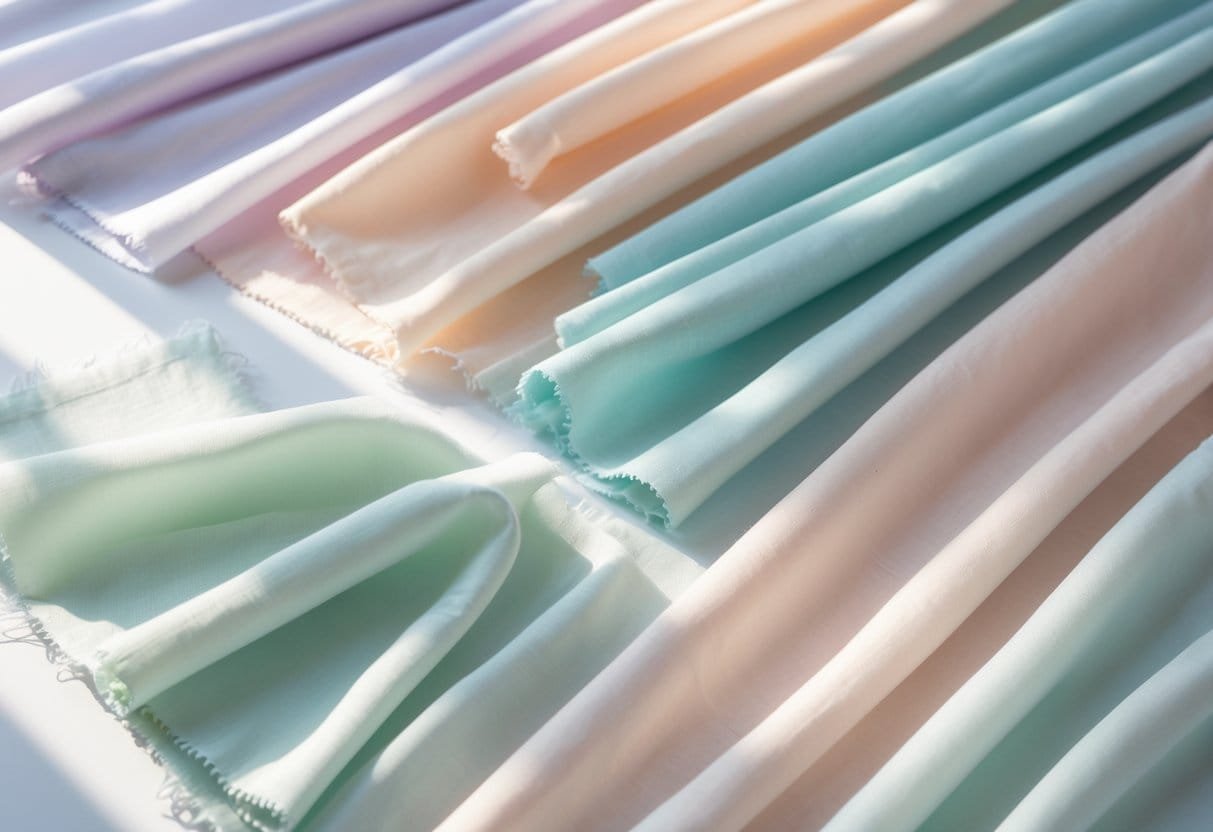
Cotton lawn is a lightweight fabric made from finely woven cotton fibers. It is known for its smooth texture and slight crispness, giving garments a soft but structured feel. This fabric is popular for warm-weather clothing because it allows air to pass through easily.
The breathability of cotton lawn makes it ideal for summer dresses, blouses, and shirts. It drapes well while maintaining shape, which helps create polished looks without heavy bulk.
Cotton lawn is also valued for its softness against the skin. It feels gentle and cool, which adds to the comfort of clothing made from it. Additionally, it is easy to sew and care for, making it a favorite among hobbyists and professionals alike.
Because it holds dye well, cotton lawn often appears in vibrant colors and patterns. Its combination of durability, lightness, and smoothness makes it versatile for many fashion projects.
23) Bamboo Fabric
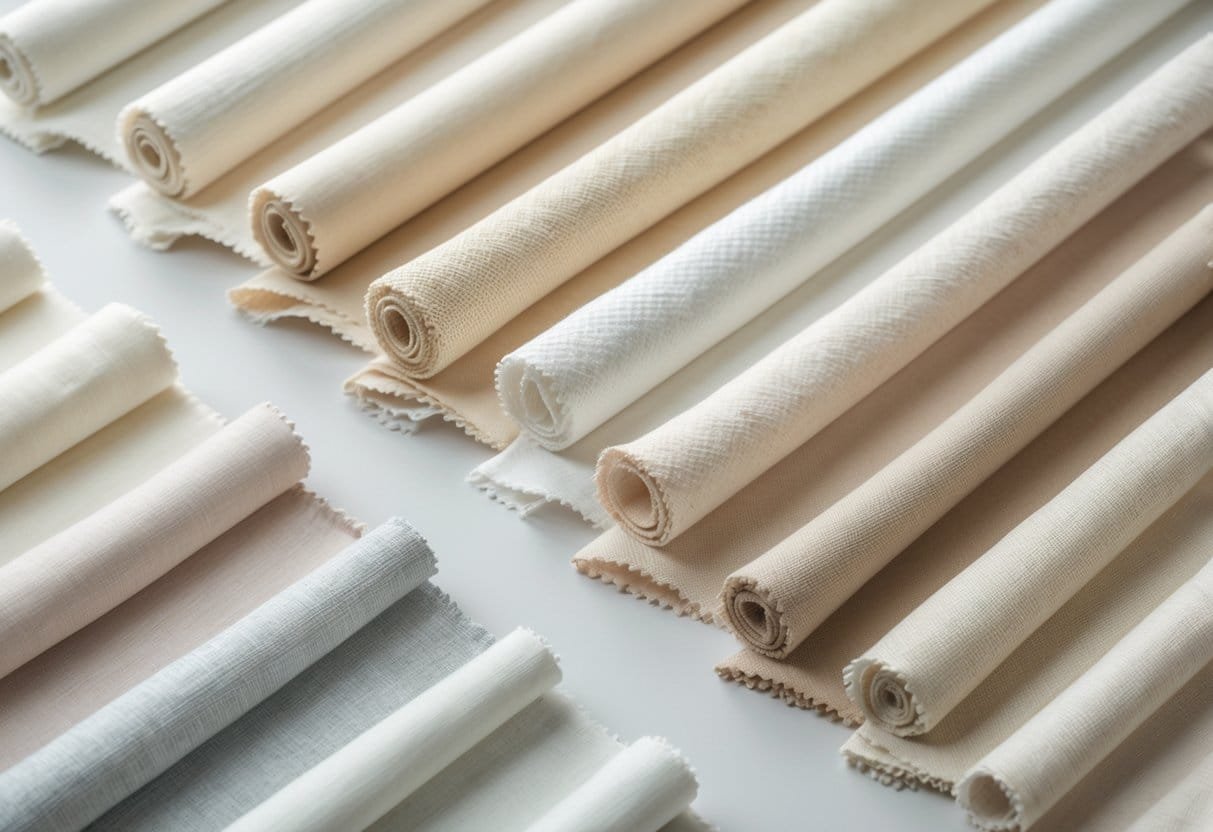
Bamboo fabric is made from the pulp of the bamboo plant. It is a lightweight and breathable material that feels soft against the skin. Because of these qualities, it is a good choice for summer clothing and activewear.
This fabric naturally absorbs moisture and allows air to pass through easily. These features help keep the wearer cool and comfortable. Bamboo fabric also has a smooth texture and a gentle drape, which adds to its appeal for making dresses, tops, and pajamas.
Many people consider bamboo fabric eco-friendly since bamboo grows quickly and uses less water than some other plants. It is also durable, so clothing made from bamboo fabric can last through regular wear.
Bamboo fabric is often blended with cotton to combine the benefits of both fibers. This blend increases softness and breathability, making it suitable for a wider range of clothing items. It is also a practical choice for babywear and casual apparel.
24) Alpaca Wool

Alpaca wool is a natural fiber known for being very light, soft, and warm. It comes from the alpaca, a camelid native to South America. The wool is hollow inside, which helps it trap heat while staying lightweight.
This fabric is popular for making winter clothing like coats, sweaters, and scarves. It offers good insulation without the bulk found in many other wool fabrics. Alpaca wool is also breathable and moisture-wicking.
Besides comfort, alpaca wool is strong and durable. It is often described as hypoallergenic because it lacks lanolin, which can irritate sensitive skin. Many brands focus on sustainably produced alpaca wool to limit environmental impact.
The texture of alpaca wool feels smooth and silky, offering a refined look for tailored clothing. It is used in high-end fashion and casual wear alike, due to its combination of lightness and warmth.
25) Cashmere Lightweight

Lightweight cashmere is a soft and breathable fabric. It offers comfort without the bulk of traditional wool. This makes it suitable for cooler days in spring or fall.
The fabric balances warmth and air flow. It can keep the wearer comfortable in changing temperatures. Lightweight cashmere is often used for sweaters and tops that are both stylish and practical.
It feels smooth against the skin and drapes well. Unlike heavier knits, it does not add much weight to clothing. This fabric is ideal for those who want luxury without excess thickness.
Lightweight cashmere also has natural insulation properties. It traps heat when needed but lets air pass through. This quality makes it useful for layering or wearing alone in mild weather.
In addition to comfort, it is known for durability. Proper care can keep cashmere garments looking good for years. It remains a popular choice for elegant and functional clothing designs.
26) Wool Crepe
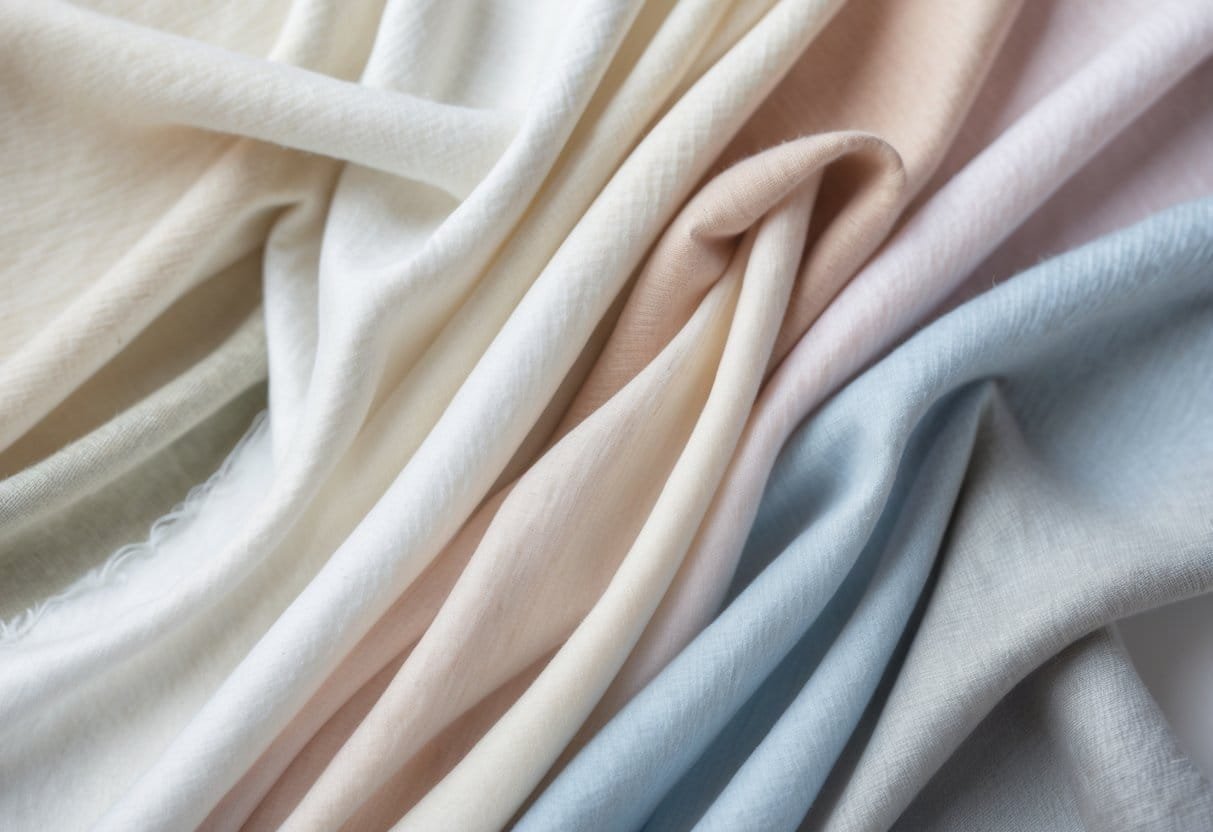
Wool crepe is a lightweight fabric made from wool fibers spun with a high twist. This twisting gives the fabric its distinct crinkled texture and subtle puckering. It makes wool crepe both durable and flexible.
The fabric is breathable and comfortable, making it suitable for tailored suits and dresses. It has natural wrinkle resistance, which helps maintain a neat appearance throughout the day. Wool crepe also stretches slightly, allowing garments to keep their shape.
It is often chosen for winter clothing because wool absorbs moisture and provides warmth. Wool crepe’s texture adds a refined look without being heavy. This fabric is a practical choice for those who want style and comfort in cooler weather.
27) Silk Satin

Silk satin is a smooth, glossy fabric known for its soft texture and natural shine. It is made from real silk fibers, which makes it breathable and comfortable to wear.
This fabric is often chosen for high-end clothing like eveningwear, bridal dresses, and lingerie. Its lightweight nature allows it to drape elegantly without feeling heavy.
Silk satin combines durability with a luxurious feel. It resists wrinkles better than many other silk fabrics, making it practical for garments that need to look polished.
Because of its fine weave, silk satin reflects light nicely. This gives clothing made from it a radiant finish that is both subtle and sophisticated.
It is ideal for those looking for a natural fabric that balances beauty and comfort. Silk satin is less common in casual clothes due to its delicate care needs and cost.
28) Ramie
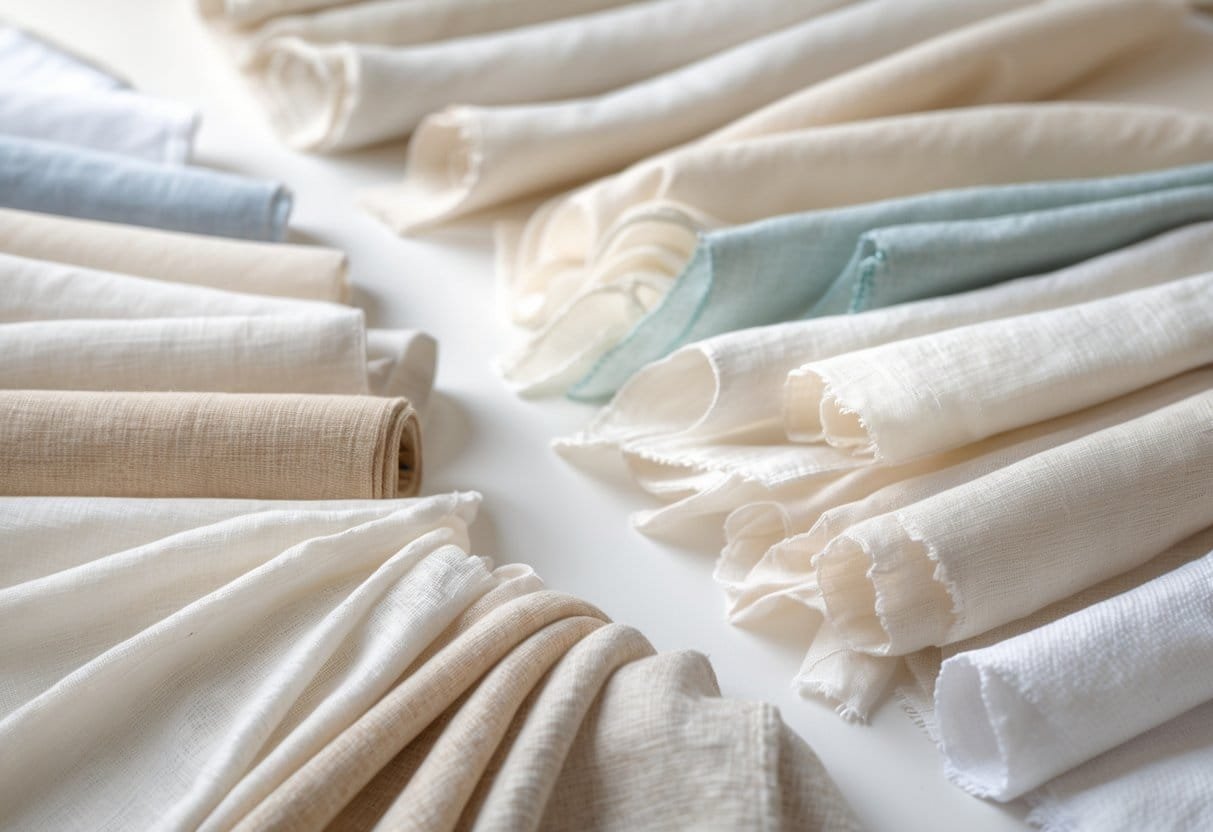
Ramie is a natural fiber derived from a plant called Boehmeria nivea. It is known for its strength, which is higher than many other natural fibers like cotton.
This fabric is lightweight and breathable. It absorbs moisture well, making it a good choice for warm weather clothing.
Ramie has a smooth texture and a natural shine. These features give clothes a polished look without needing extra treatments.
It is also valued for being eco-friendly. The plant grows quickly and requires fewer resources than cotton to cultivate.
Ramie is often blended with other fibers to improve softness and elasticity. It can be found in summer wear, home textiles, and eco-conscious fashion lines.
Despite its benefits, ramie can be stiff on its own. Manufacturers usually treat or blend it to make it more comfortable for everyday wear.
29) Tencel Lyocell
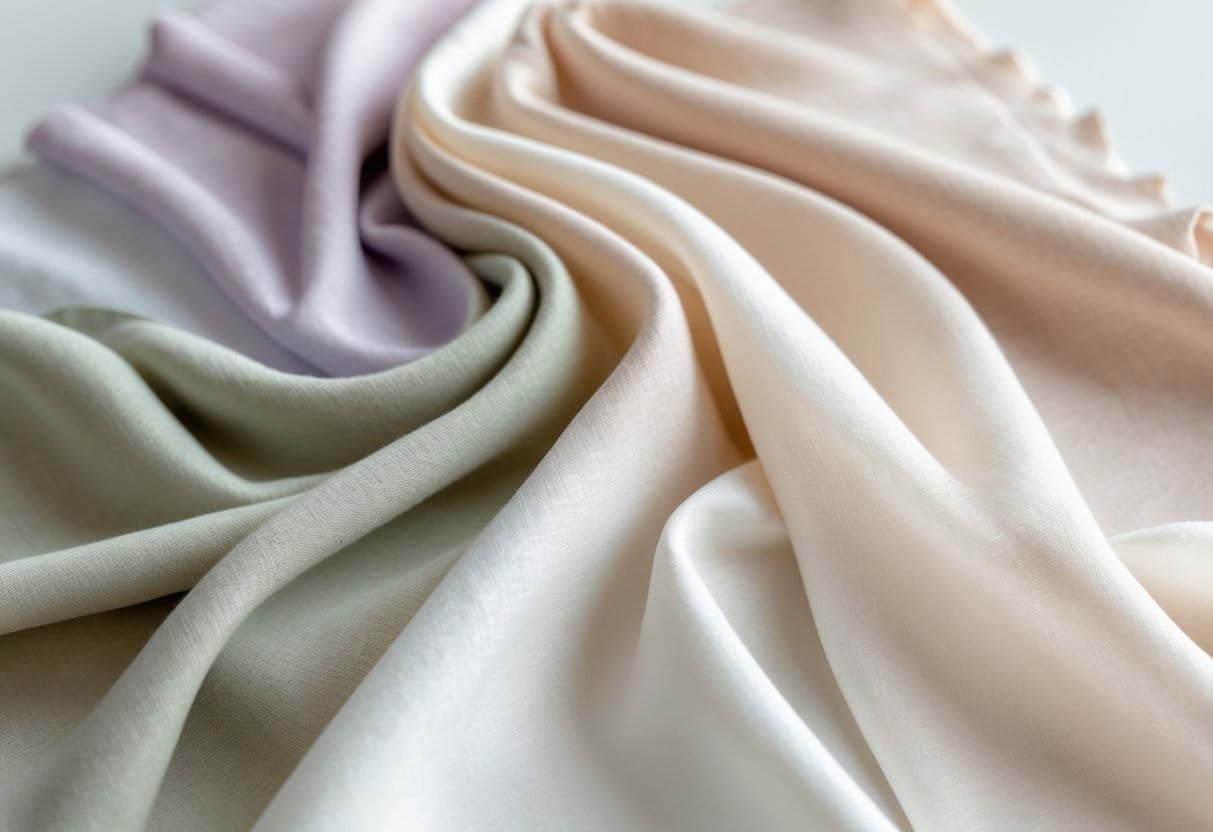
Tencel Lyocell is a lightweight fabric made from wood pulp. It is known for being soft, breathable, and smooth to the touch. This fabric allows air to pass through easily, making it comfortable to wear in warm weather.
The production process of Tencel Lyocell uses a closed-loop system. This means most of the chemicals and water used are recycled. It makes the fabric more eco-friendly compared to many other fibers.
Tencel Lyocell clothing often drapes well and feels cool on the skin. It is also strong and absorbs moisture, which helps keep the wearer dry. Many brands use Tencel in shirts, dresses, and pants.
Because of its natural origin and comfort, Tencel Lyocell is popular for sustainable fashion. It combines durability with softness, appealing to those who want breathable and lightweight clothing.
Key Benefits of Lightweight Fabrics
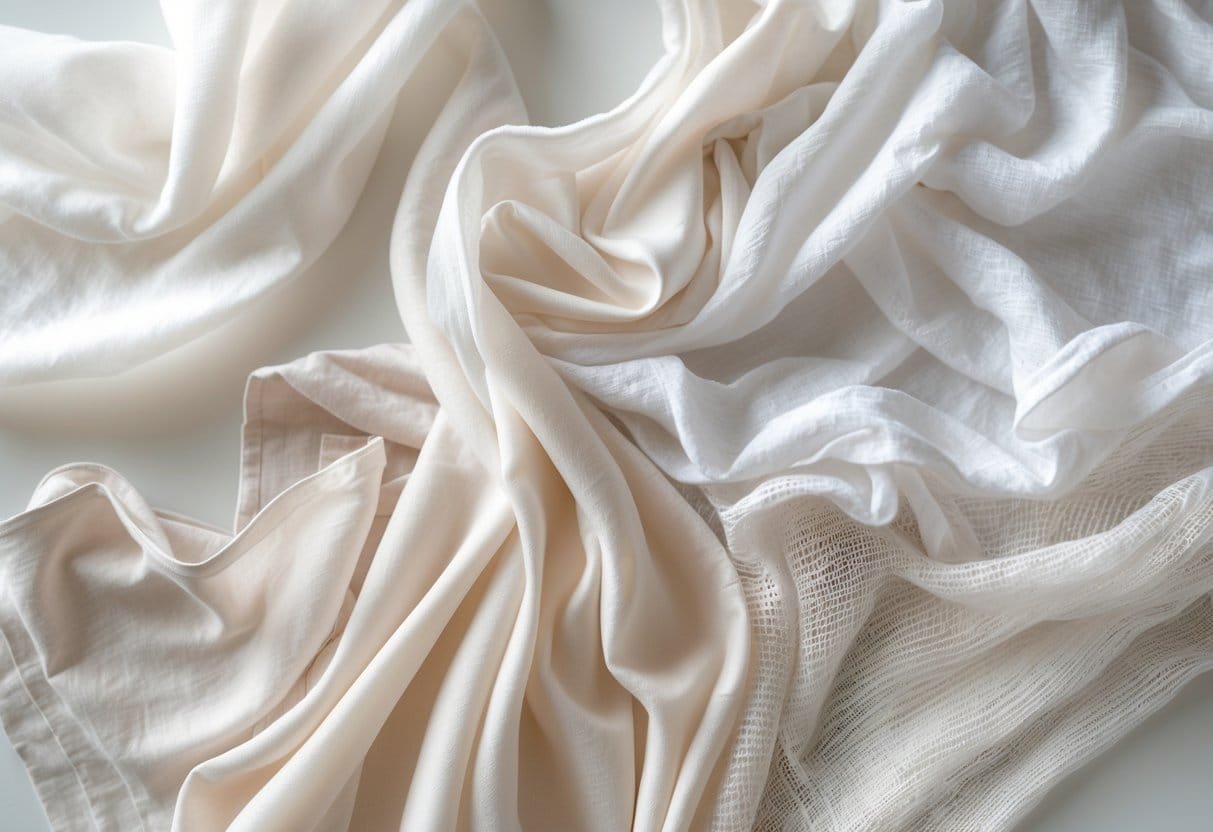
Lightweight fabrics offer distinct advantages that improve clothing performance in various ways. They enhance comfort by allowing air flow, simplify outfit layering, and make travel packing easier and more efficient. These qualities make lightweight fabrics a practical choice for many types of clothing.
Breathability and Comfort
Lightweight fabrics are often made from materials like cotton voile, chiffon, linen, and silk. These fabrics have low GSM (grams per square meter), which means they allow air to pass through easily. This helps the wearer stay cool and dry, especially in hot or humid conditions.
The breathability reduces sweat buildup, making lightweight fabrics ideal for summer wear and activewear. Some also wick moisture away from the skin. This keeps the wearer comfortable during exercise or outdoor activities. Lightweight fabrics tend to feel softer and less restrictive compared to heavier textiles, improving overall ease of movement.
Ease of Layering
Because lightweight fabrics are thin and flexible, they work well for layering clothing. People can combine multiple layers without feeling bulky. This is useful for changing temperatures or varying settings, such as moving from outdoors to indoors.
The thin nature of these fabrics lets them fit smoothly under heavier garments like jackets or sweaters. This creates better insulation without excess weight. Additionally, the different textures available in lightweight fabrics, from silky to sheer, allow for varied styling and functional uses without adding volume.
Travel and Packing Advantages
Lightweight fabrics reduce the overall weight and bulk of packed clothing. This makes them ideal for trips where luggage space is limited. Clothes made from these fabrics take up less room and weigh less, helping travelers avoid extra baggage fees.
Travelers benefit from fabrics that dry quickly and resist odors. These qualities let clothes be washed and worn again with minimal hassle. Lightweight, moisture-wicking materials keep travelers fresh during long journeys. Apparel made from these fabrics offers convenience and comfort in a compact form.
Care and Maintenance Tips
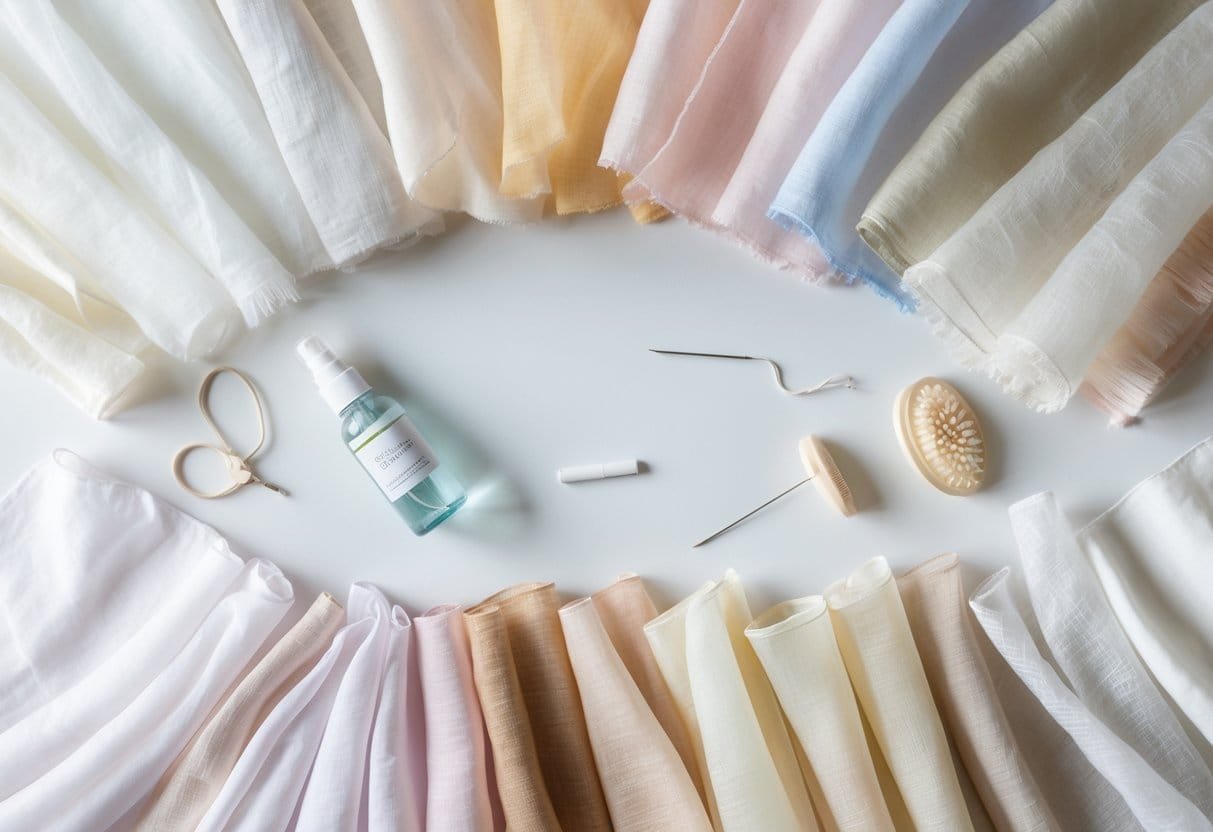
Proper care keeps lightweight fabrics looking good and lasting longer. Different fabrics need specific handling to avoid damage. Knowing how to wash, store, and maintain these materials helps preserve their look and feel.
Washing Guidelines
Lightweight fabrics often need gentle washing to keep their texture and strength. Using cold water or warm water on a delicate cycle is best for materials like silk, chiffon, and voile.
Avoid harsh detergents. Instead, use mild soaps or fabric-specific cleaners. These protect delicate fibers and colors.
Hand washing is ideal for very fine fabrics, as it reduces stretching or tearing. When machine washing, put clothes in a mesh bag to prevent friction.
Always check care labels for temperature and method recommendations. Avoid bleach unless it is safe for the fabric.
Ironing and Storage
Many light fabrics wrinkle easily but can be damaged by high heat. Iron on a low setting or use steam to relax creases.
For silk and polyester blends, a pressing cloth between the iron and fabric prevents shine or burns. Avoid ironing directly on delicate surfaces.
Store lightweight fabrics on padded hangers to keep shape and prevent wrinkles. If folding, place acid-free tissue paper between folds to reduce creasing.
Keep fabrics away from direct sunlight during storage to avoid fading. Use breathable garment bags instead of plastic to protect against moisture and mildew.
Longevity Best Practices
Regularly inspect garments for stains, loose threads, or wear. Treat stains promptly using gentle spot-cleaning methods suitable for each fabric type.
Rotate wearing lightweight clothes to avoid frequent stress in the same areas. This reduces thinning and damage.
Avoid overloading the washing machine, which can cause friction and pilling. Air dry whenever possible, as heat from dryers can weaken fibers.
Proper care routines, attention to detail, and storage habits extend the life of lightweight fabrics and keep them looking fresh.
Frequently Asked Questions
This section addresses the common questions about lightweight fabrics. It covers the best options for summer dresses, fabrics known for thinness and durability, ultra-lightweight materials, soft fabrics, flowy yet opaque options, and how fabric strength is measured.
What are the top lightweight fabrics suitable for summer dresses?
Cotton Voile and Linen are excellent choices for summer dresses because they are breathable and light.
Chiffon and Tencel offer a delicate feel and smooth texture, making them popular for airy, comfortable clothing.
Which types of fabric are known for being exceptionally thin yet durable?
Tencel stands out for its strength despite being very thin.
Linen is also durable and thin, with fibers that resist wear while staying lightweight.
What varieties of ultra-lightweight materials are used in garment production?
Chiffon is a common ultra-lightweight fabric known for its sheer quality.
Rayon and Cotton Voile also rank high due to their light nature and versatility in different styles.
Can you list some super soft fabrics that are also lightweight?
Tencel offers a soft hand feel while remaining light and breathable.
Rayon is known for softness combined with a lightweight design that suits many garments.
What fabrics provide a flowy appearance while maintaining opacity?
Cotton Voile and Linen create a nice flow due to their drape, and they keep garments opaque.
Rayon can also offer a flowy look but may vary in opacity depending on the weave.
How is the strength of lightweight clothing materials measured against their weight?
Strength is measured by thread thickness and fiber quality relative to fabric weight.
Tests include tensile strength and durability to ensure lightweight fabrics hold up in use without adding bulk.







